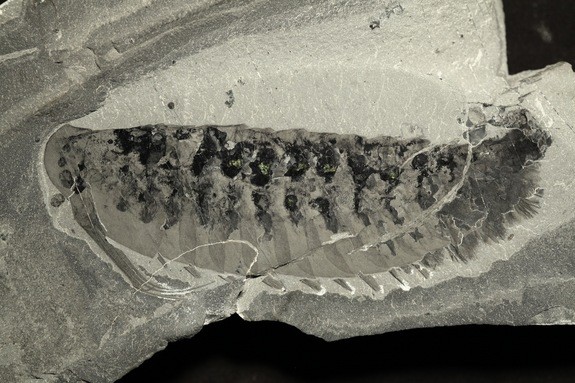Scientists Unearth Ancient Lobster-Like Creature
| Marco Foronda | | Mar 27, 2015 11:57 PM EDT |
(Photo : Jean-Bernard Caron/Royal Ontario Museum) Holotype of Yawunik kootenayi.
Scientists have unearthed a 508 million year-old lobster relative that had appendages equipped with three claws and a terrifying set of teeth.
Yawunik kootenayi, a marine creature with two pairs of eyes and prominent grasping appendages, lived 250 million years before the first dinosaur.
Like Us on Facebook
The recently identified fossil is the first new species to be described from the Marble Canyon site, part of the Canadian Burgess Shale fossil deposit.
"This creature is expanding our perspective on the anatomy and predatory habits of the first arthropods, the group to which spiders and lobsters belong. It has the signature features of an arthropod with its external skeleton, segmented body and jointed appendages, but lacks certain advanced traits present in groups that survived until the present day. We say that it belongs to the 'stem' of arthropods," said Cedric Aria, a PhD candidate at the University of Toronto's Department of Ecology & Evolutionary Biology and lead author of the study.
The creature developed long frontal appendages that look like the antennae of modern beetles or shrimps. These appendages were composed of three long claws, two of which bore opposing rows of teeth that helped the animal catch its prey.
The study presents evidence Yawunik was capable of moving its frontal appendages backward and forward, spreading them out during an attack and then retracting them under its body when swimming.
Coupled with the long, sensing whip-like flagella extending from the tip of the claws, this makes the frontal appendages of the animal some of the most versatile and complex in all known arthropods.
Study authors suggest Yawunik was at the top of the food chain and played a vital role in the ancient ecosystem. They named it after the local mythological marine creature "Yawunik" as an homage to the Ktunaxa People who have long inhabited the Kootenay area where the fossils were found.
The new discovery was published in the journal Palaeontology.
TagsScientists Unearthed Ancient Lobster-Like Fossils, lobster, marine creature, ancient lobster, Yawunik, Yawunik kootenayi, 508 million-year-old lobster, Fossils, marine fossils, Ecosystem, Dinosaur era
©2015 Chinatopix All rights reserved. Do not reproduce without permission
EDITOR'S PICKS
-

Did the Trump administration just announce plans for a trade war with ‘hostile’ China and Russia?
-

US Senate passes Taiwan travel bill slammed by China
-

As Yan Sihong’s family grieves, here are other Chinese students who went missing abroad. Some have never been found
-

Beijing blasts Western critics who ‘smear China’ with the term sharp power
-

China Envoy Seeks to Defuse Tensions With U.S. as a Trade War Brews
-

Singapore's Deputy PM Provides Bitcoin Vote of Confidence Amid China's Blanket Bans
-

China warns investors over risks in overseas virtual currency trading
-

Chinese government most trustworthy: survey
-

Kashima Antlers On Course For Back-To-Back Titles
MOST POPULAR
LATEST NEWS
Zhou Yongkang: China's Former Security Chief Sentenced to Life in Prison

China's former Chief of the Ministry of Public Security, Zhou Yongkang, has been given a life sentence after he was found guilty of abusing his office, bribery and deliberately ... Full Article
TRENDING STORY

China Pork Prices Expected to Stabilize As The Supplies Recover

Elephone P9000 Smartphone is now on Sale on Amazon India

There's a Big Chance Cliffhangers Won't Still Be Resolved When Grey's Anatomy Season 13 Returns

Supreme Court Ruled on Samsung vs Apple Dispute for Patent Infringement

Microsoft Surface Pro 5 Rumors and Release Date: What is the Latest?










